
Table of Contents
- Why Our Feet Swell After Sitting for a Few Hours in a Chair?
- How Can You Fix This?
- 1. Fix your diet
- 2. Reduce body weight
- 3. Use compression socks
- 4. Wear comfortable shoes
- 5. Drink plenty of water
- 6. Keep your body active
- 7. Use standing desks
- 8. Under desk footrest
- 9. Balance board
- 10. Avoid sitting for long
- 11. Under desk treadmill
- 12. Calf stretches
- 13. Keep your feet elevated
- 14. Do massage regularly
- 15. Sit with your feet flat on the ground
- 16. Use support equipment
- 17. Ankle flexes
- 18. Foot pumps
- 19. Leg lifts
- 20. Ankle circles
- 21. Walking
- FAQs
During this quarantine, many of you might be in some kind of remote work. Also, you probably spend more time sitting than usual. A lot of people have this one condition that affects them after spending too much time sitting with swollen feet. You may have seen yourself too if you stay seated for a long time. Usually, you begin to feel tightness around your lower legs and ankles. If you have this and would like to know how to prevent feet swelling while sitting at desk then you’ve come to the right place.
Dependent edema is the medical term for this condition. In this condition, your body's tissues become clogged with extra fluid. Gravity pulls fluid down your legs and feet as you sit and especially if your legs are hanging down the front of the seat for a long time. Because of this, you might end up with swollen feet and might only notice it if you’ve been seated for a long time. The first thing to do is understand why this is happening and how to prevent feet swelling while sitting at a desk.
Why Our Feet Swell After Sitting for a Few Hours in a Chair?
Gravity plays a key role in everything. The blood vessels in our bodies leak. The lymphatic system removes fluid from the legs and feet by returning fluid to circulation. Muscle activity is required to circulate it, just as venous blood return from the legs is dependent upon muscle activity.
Sitting causes the major muscles of the legs to become almost inactive, and they do not squeeze the vessels to move fluid. Walk for five minutes every hour by getting out of your reclining office chair with a footrest or ergonomic desk stool. A family physician should be consulted if this is a new symptom. It is possible to have more serious problems, and even medical intervention might be required to keep feet from swelling.
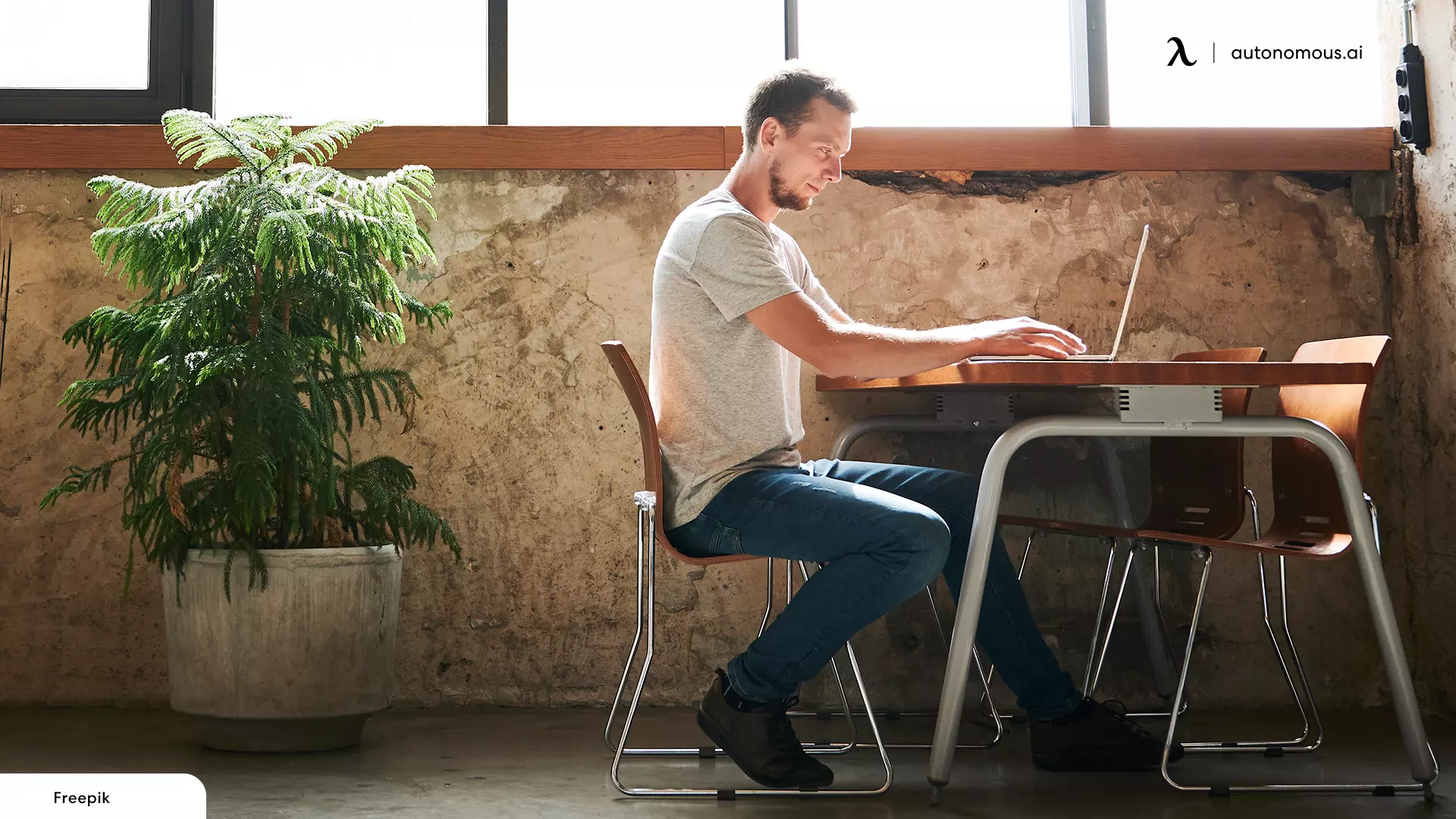
How Can You Fix This?
To begin with, ensure that your feet swelling is not the result of underlying health issues by getting a health check-up. Once you've done some 'deskercise,' move on to the next step! Office workers are having a hard time fitting exercise into their busy schedules these days, so 'deskercise' has become a huge trend among the remote working kind as it saves them time on learning how to prevent feet from swelling.
There are, however, many exercises that are not very practical for office workers: you might be able to do lunges or squats using your motorized standing desk legs as a support to stop feet from swelling. This works great if your workstation has a door you can close for a little bit of privacy, but most of us do work in cubicles or shared desk spaces, and would prefer not to be jammed in a yoga position!
You should, however, take up some kind of leg exercises at work whenever possible to prevent stiffness and discomfort and prevent varicose veins from developing due to poor circulation. Leg exercises that we recommend here are easier and subtle and you don't need to worry about looking weird if you do them while you’re seated on your standing desk.
1. Fix your diet
The first and most important step to prevent any disease or health-related issue is to fix your diet. A diet with healthy foods will promote heart health, reducing the risk of your feet swell when sitting in the office. If you look more towards the medical side, more intake of sodium can increase the fluid retention in your body, causing your feet to swell.

2. Reduce body weight
Reducing weight is not only limited to people suffering from how to prevent feet swelling while sitting at desk. Obesity is a problem that leads to many life-threatening diseases. It creates pressure on your veins and interferes with the proper blood flow throughout your body. By losing weight, you will not only reduce your swelling if it already exists but also notice drastic changes in your body's resistance level against swelling issues.
3. Use compression socks
Once you maintain a healthy diet and reduce weight, it's time to use some other things for better work life. Compression socks are some of the most common items to wear for people suffering from swollen feet and legs and ankles swelling from sitting for long hours. They offer gentle compression to the legs to improve the blood flow throughout your body, including the legs.
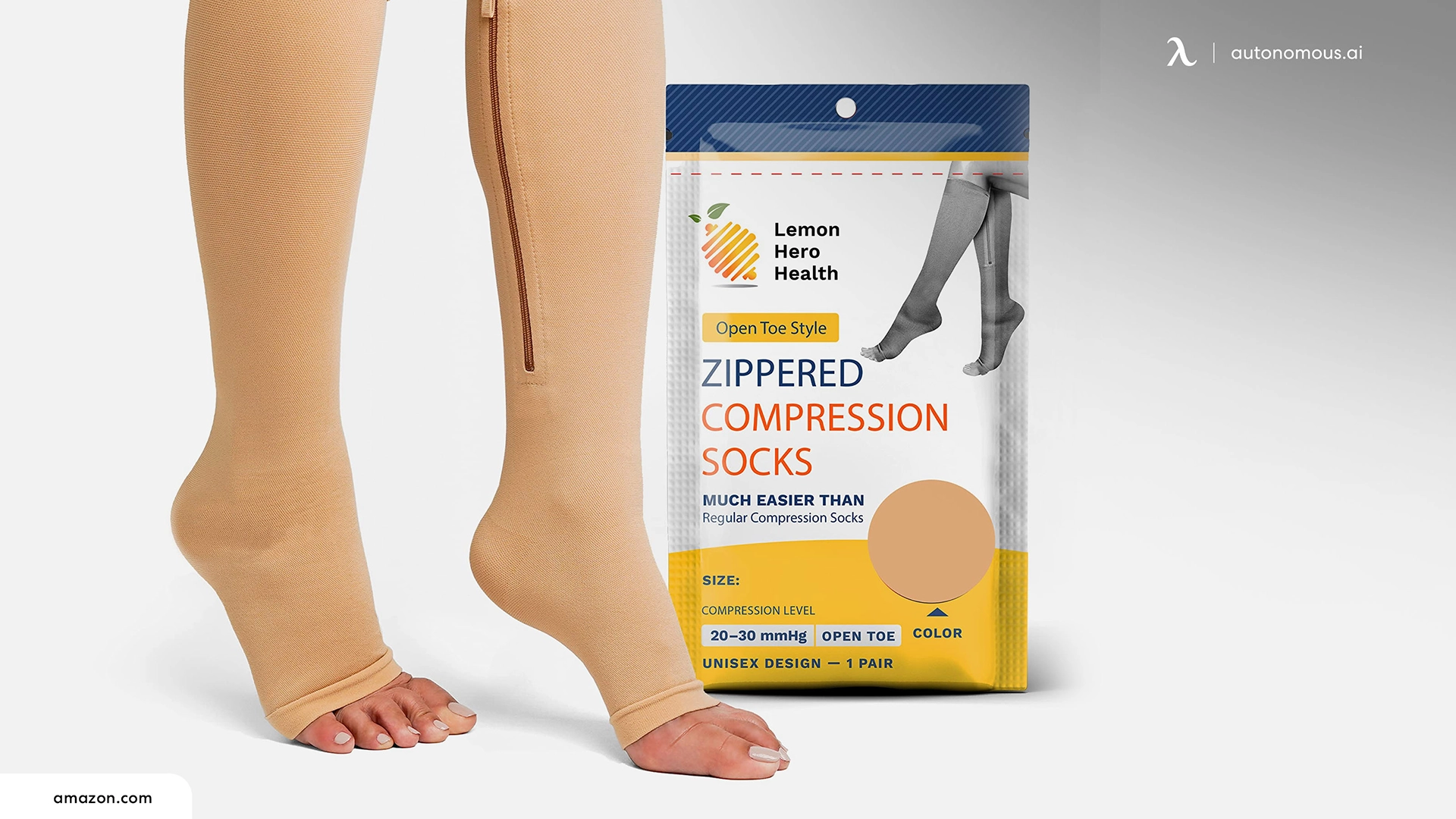
4. Wear comfortable shoes
It may sound a bit strange, but your shoes play a key role in increasing your productivity at work and the way how to prevent feet swelling while sitting at desk. Comfortable shoes can bring the best out of you at work, as it's not possible for everyone to wear them off while sitting on your office chair. High heels and dress shoes affect your natural walking style and produce pain and swelling over time. Changing your shoes to ones that have some breathing room might change your life in this case.
5. Drink plenty of water
Fluid retention is worsened by a deficiency of water in the body. With dehydration, the amount of sodium increases in the body, causing pooling in the lower part of your body when you sit for long hours. To solve this problem, all you need to do is to drink plenty of water throughout the day. It would not only keep you healthy and hydrated but also solve swollen feet problems forever.

6. Keep your body active
Sitting for long hours is the main reason for swollen feet and legs, so why not move from your office chair and walk for a bit before going back to work? This would not only make you more active but help your blood to flow better throughout the body. Changing your posture every 30 minutes can also help reduce pain and improve blood flow.
7. Use standing desks
Heigh adjustable desks is a great way to solve all your feet and leg swelling problems. These desks are built in such a way that you can adjust their height to make the surface elevated from its natural position, allowing you to work while standing as well. This changes your posture and helps you improve your blood flow to reduce swelling and other problems that occur due to sitting for long hours.
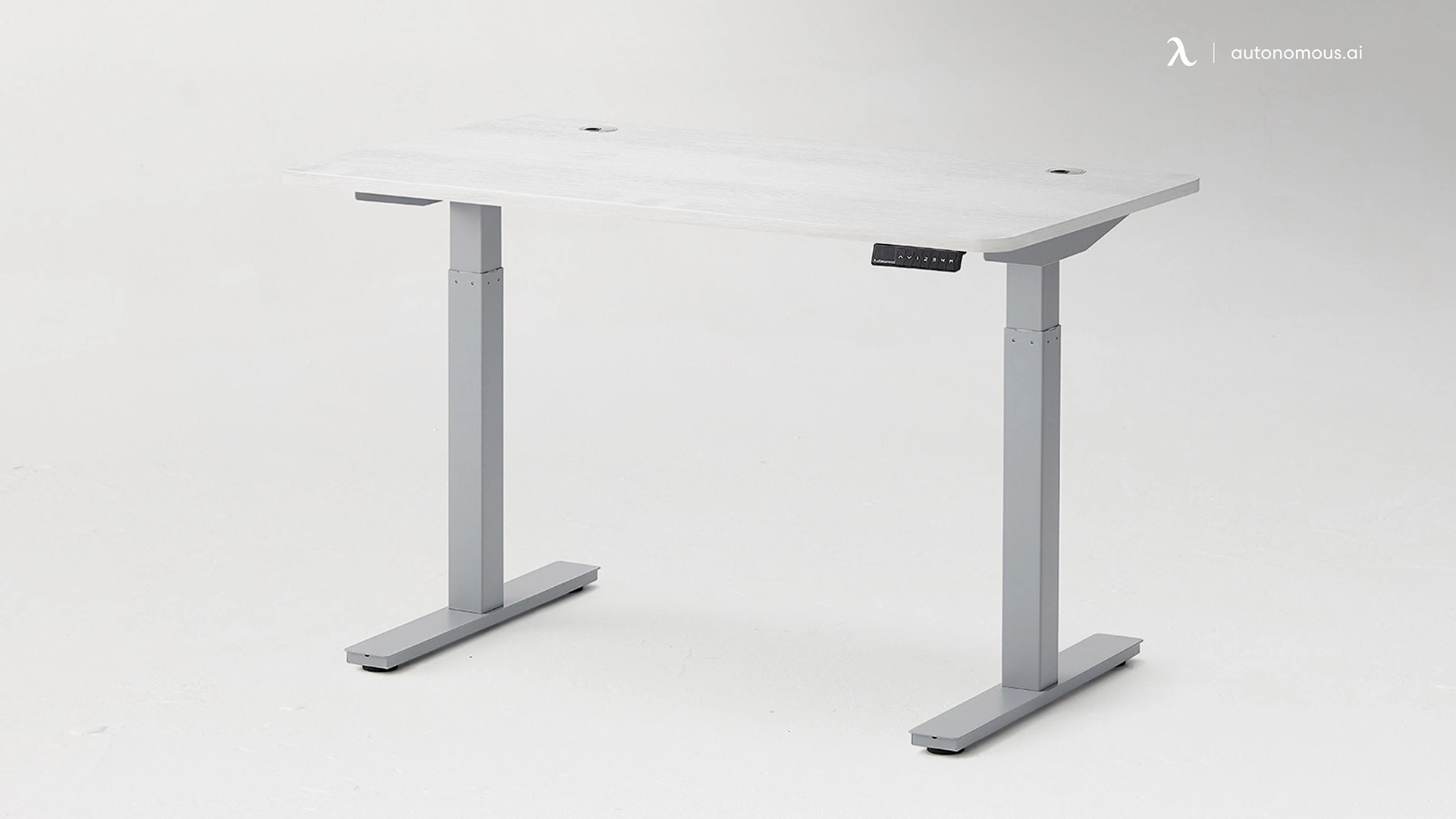
.jpg)
SmartDesk 2
| Top | Classic Top |
|---|---|
| Dimensions | 53"L x 29"W x 1"H |
| Shipping dimensions | 56"L x 33"W x 3"H x 47 lbs |
| Colors | White, Black, Walnut, White Oak, Bamboo |
| Material | Warp-proof MDF wood Natural Bamboo |
| Motor type | Dual | Dual |
|---|---|---|
| Lifting speed | 1.1”/sec | 2.3”/sec |
| Lifting capacity | 250 lbs | 310 lbs |
| Noise level | 45 dB | 40 dB |
| Height range (without top) | 27.2" - 46.5" | 25.2" - 51" |
| Height range (with top) | 28.3" - 47.5" | 26.2" - 52" |
| Length range | 39.8'' - 59'' | 40" - 73" |
| Frame foot width | 23.6'' | 27.5" |
| Material | SPCC steel | SPCC steel |
| Colors | White, Black | White, Black, Grey |
| Outlet voltage | 110-240V | 110-240V |
| Anti - collision | Yes | Yes |
| Shipping dimensions | 39"L x 11"W x 9"H x 51 lbs | 43"L x 13"W x 10"H x 70 lbs |
| Pros | Cons |
| Offers Standard (2-stage) and Max (3-stage) frames to suit different needs. | Standard model's height range may not suit very tall or short users. |
| Height range from 25.2" to 51" with memory settings. | Limited surface size (53"x29"). |
| Supports up to 310 lbs, ideal for heavy setups. | Assembly might be more complex and time-consuming |
| Quiet operation at 40-45 dB. | |
| Made with sustainable FSC-certified materials. | |
| Sturdy build: SPCC steel, ANSI/BIFMA certified. | |
| Anti-collision technology for safety. | |
| Quick assembly: 10-20 minutes. | |
| Warranty: 10 years on the frame, 1 year on the top. |
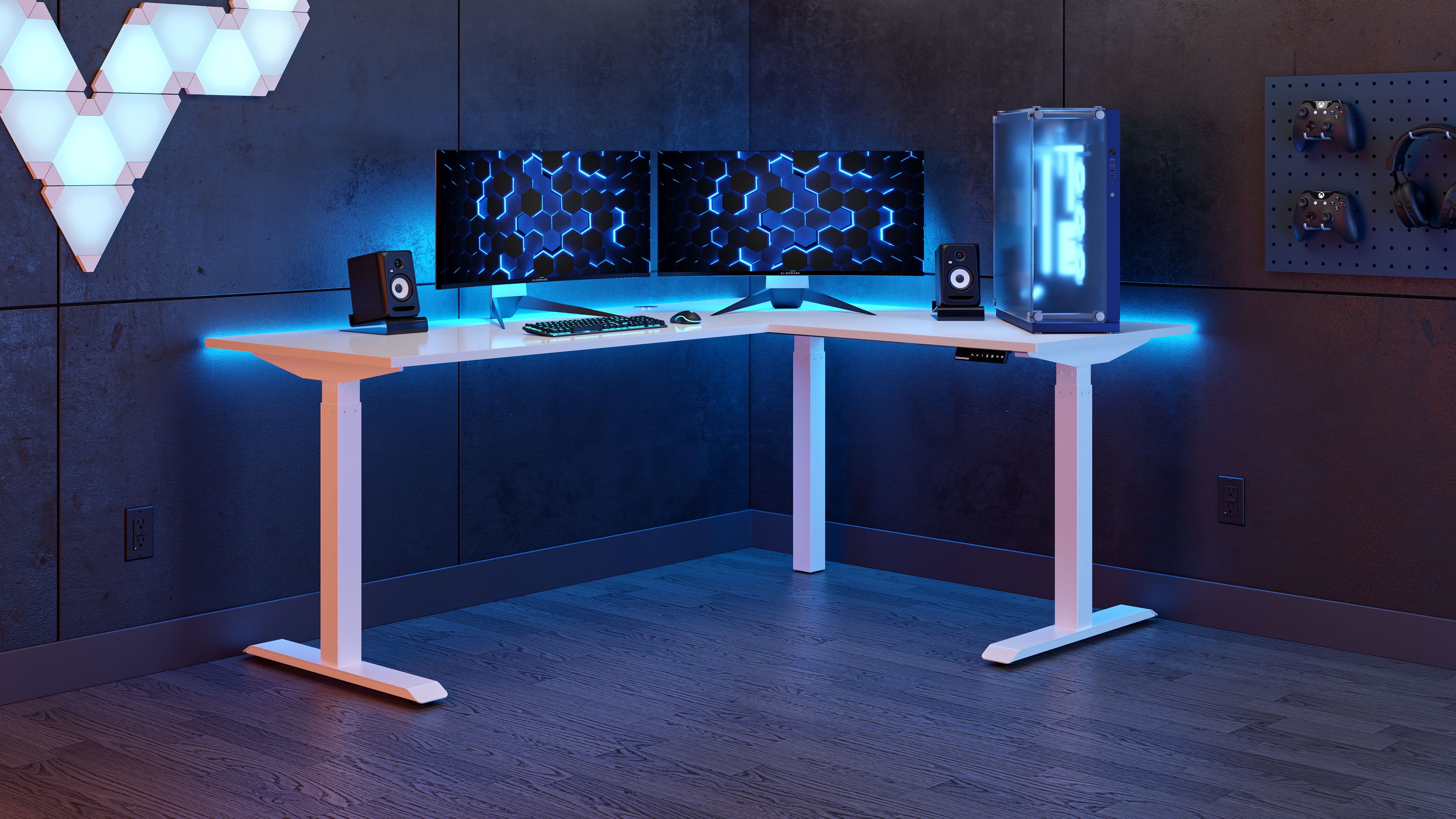
SmartDesk 2 L-Shaped
| Dimensions | Full: 77”L x 64”W x 1”H Large Top: 77”L x 29”W x 1”H Small Top: 29”L x 35”W x 1”H |
|---|---|
| Shipping Dimensions | 84"L x 35"W x 5"H x 95 lbs |
| Colors | White, Black, Walnut |
| Material | Warp-proof MDF wood |
| Motor type | Triple |
|---|---|
| Lifting speed | 2.3”/sec |
| Lifting capacity | 400 lbs |
| Noise level | 50 dB |
| Height range (without top) | 28.4" - 47" |
| Height range (with top) | 29.4" - 48" |
| Length range | 42” - 71” |
| Frame foot width | 27.5" |
| Material | SPCC steel |
| Colors | White/ Black |
| Outlet voltage | 110-240V |
| Anti - collision | Yes |
| Shipping Dimensions | Box 1: 54"L x 12"W x 8"H x 51 lbs Box 2: 35"L x 21"W x 9"H x 55 lbs |
| Pros | Cons |
| The L-shaped design offers extensive room for monitors, laptops, and other work essentials. | Larger size and weight may complicate the assembly process. |
| Triple motor system with a 400 lbs lifting capacity ensures strong, reliable operation. | |
| Operates at a low noise level of 50 dB, keeping your workspace serene. | |
| Easily switch the desk’s orientation to fit any workspace layout. | |
| SPCC steel frame with BIFMA certification provides long-lasting stability. | |
| Designed for quick assembly in just 15-30 minutes. | |
| Premium finish from White, Black, or Walnut, with warp-proof MDF wood tops. |
8. Under desk footrest
Under desks, footrests make a comfortable, relaxing surface for your feet. Placing your feet on such footrests for hours won't affect the blood flow or swell your feet. Some footrests in the market also offer height adjustability, which takes comfort to the next level. One of the best under-desk footrests in the market is called the Ergofoam footrest, which comes with a mesh cover and adjustable height features.
9. Balance board
Balance board is another alternative for people who want to get rid of feet swell when sitting. It enhances energy and muscle memory through micromovements. The board is built specifically for people who want to multi-task, as it activates the core muscle while standing.
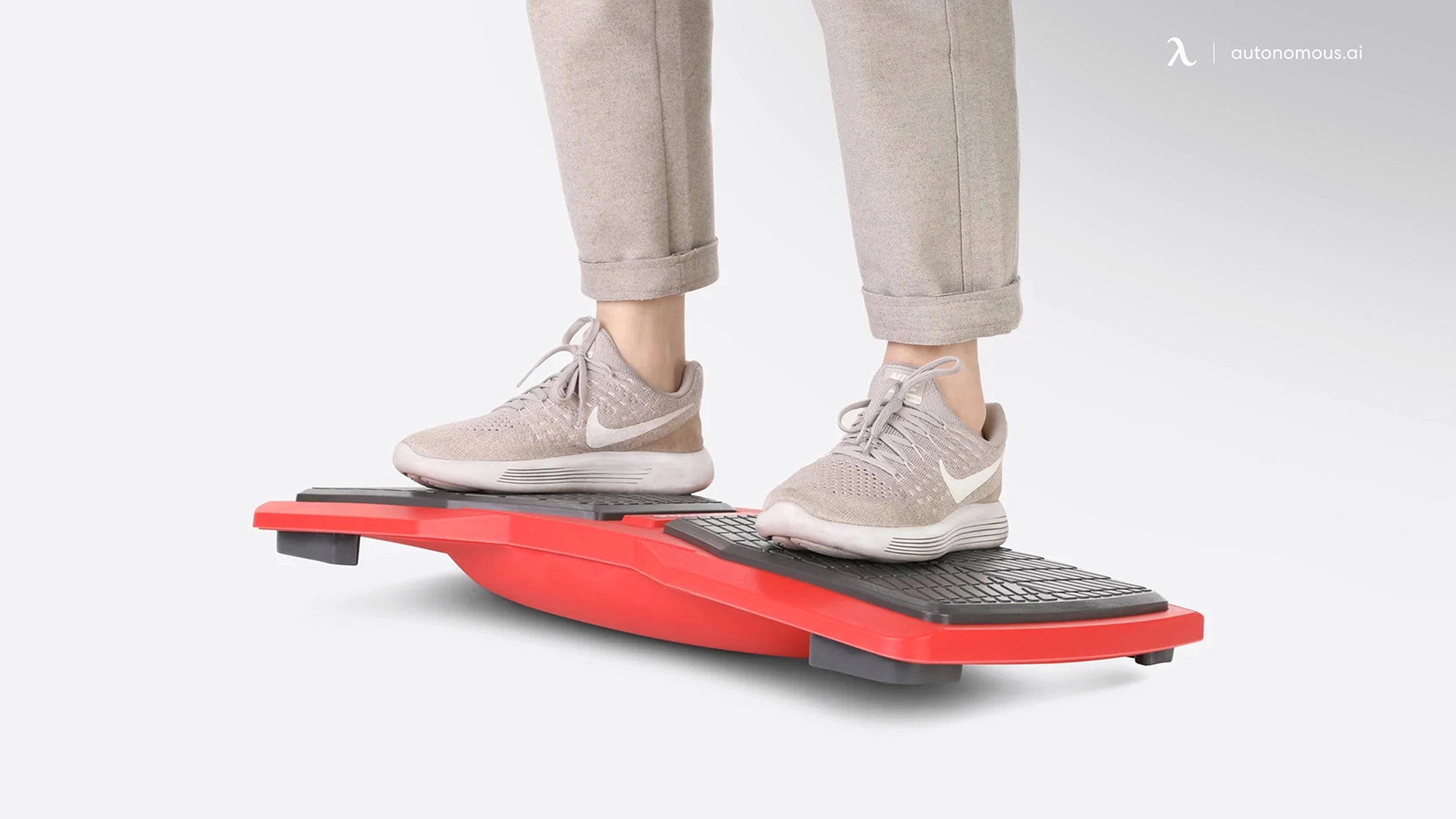
10. Avoid sitting for long
People prone to swollen feet and leg pain problems should avoid sitting for long hours in the first place. No matter how important the work is, nothing gets right when you are not healthy for feet swell when sitting. Change your position every hour and determine the maximum time your feet can maintain a position without getting hurt. Use the data to plan your working hours and sitting periods.
11. Under desk treadmill
Under-desk treadmills work wonders for those who want to keep their body active while working. These treadmills are designed to make you work for long hours without getting tired. You can slip the treadmill under your standing desk and use it while working on your laptop to solve your feet swelling from sitting issues.
12. Calf stretches
To do this exercise, hold your feet just above the ground and stretch your legs out in front of you when seated on your office chair. You should feel a stretch in your calf muscle as you raise the toe of your right foot towards your shin and bend your ankle. Your left foot should be stretched to the ground while your right foot is stretched to the ground. You will then switch, lowering your right toe to the ground while raising your left toe. 30 seconds is a good time to settle into a rhythm.
13. Keep your feet elevated
Keeping your feet elevated from the ground won’t allow the fluid to be accumulated in your feet. This would reduce the swelling and pain while sitting for long hours. If you raise your feet to your heart level, the blood will flow back to the heart, decreasing swelling with time. To solve the issue permanently, keep your feet elevated for about half an hour daily.
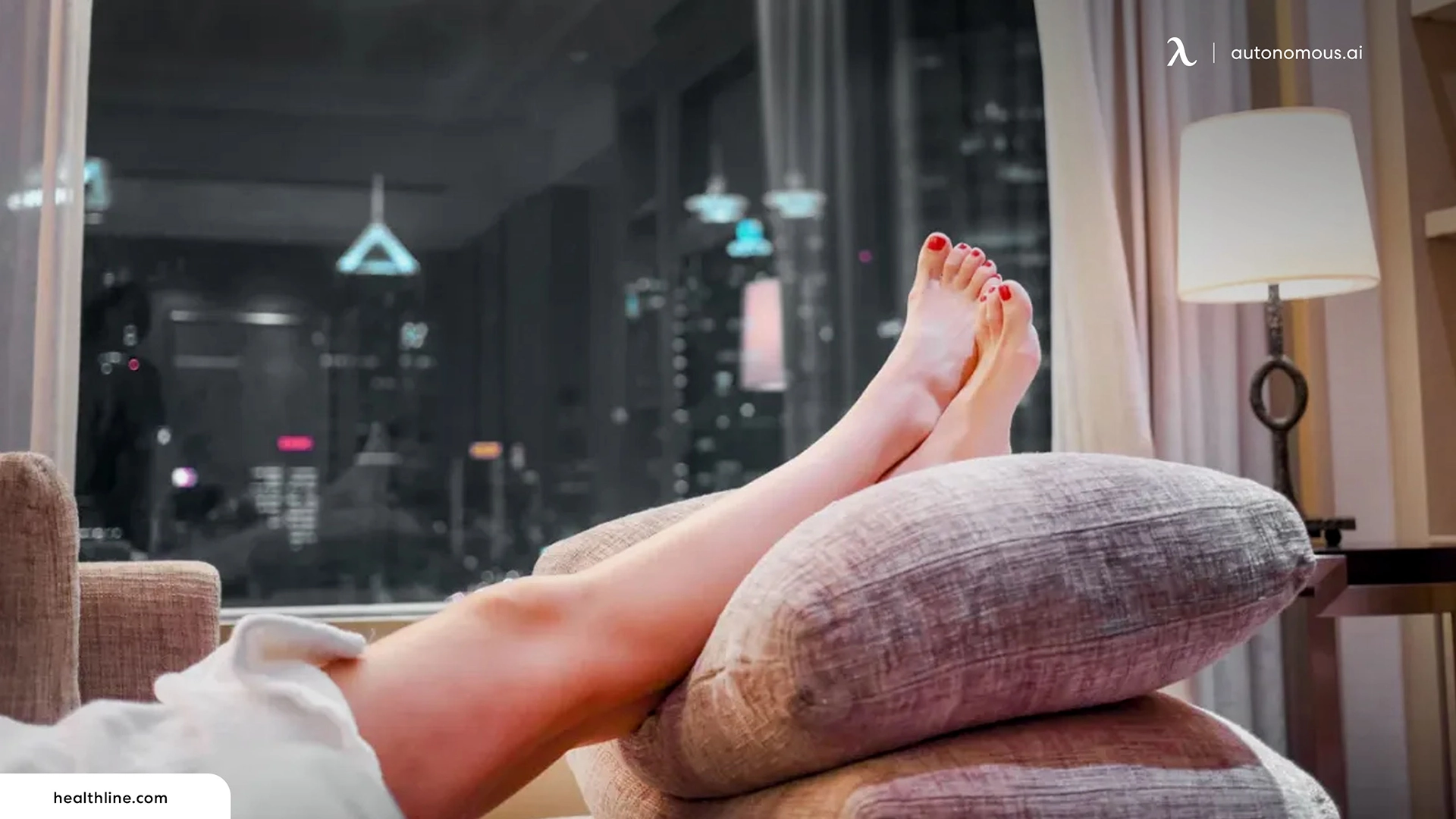
14. Do massage regularly
Massaging your feet and other parts of your body is the best way to improve blood flow and keep your body active throughout the day. It relaxes your muscles and reduces stress. Some of the most common foot massage techniques include squeezing and chopping motions. For squeezing exercise, use your fingers to squeeze the ankles and move them up towards the limbs. On the other hand, the chop motion is done by using your palm to gently massage your legs from bottom to top.
15. Sit with your feet flat on the ground
A good posture allows you to tackle all physical health-related problems like feet swelling from sitting during work. Adjust the height of your seat and keep your feet flat on the surface. This would reduce the chances of your feet swelling or feeling pain. However, this won't be effective for one sitting for hours, where moving from position becomes necessary.
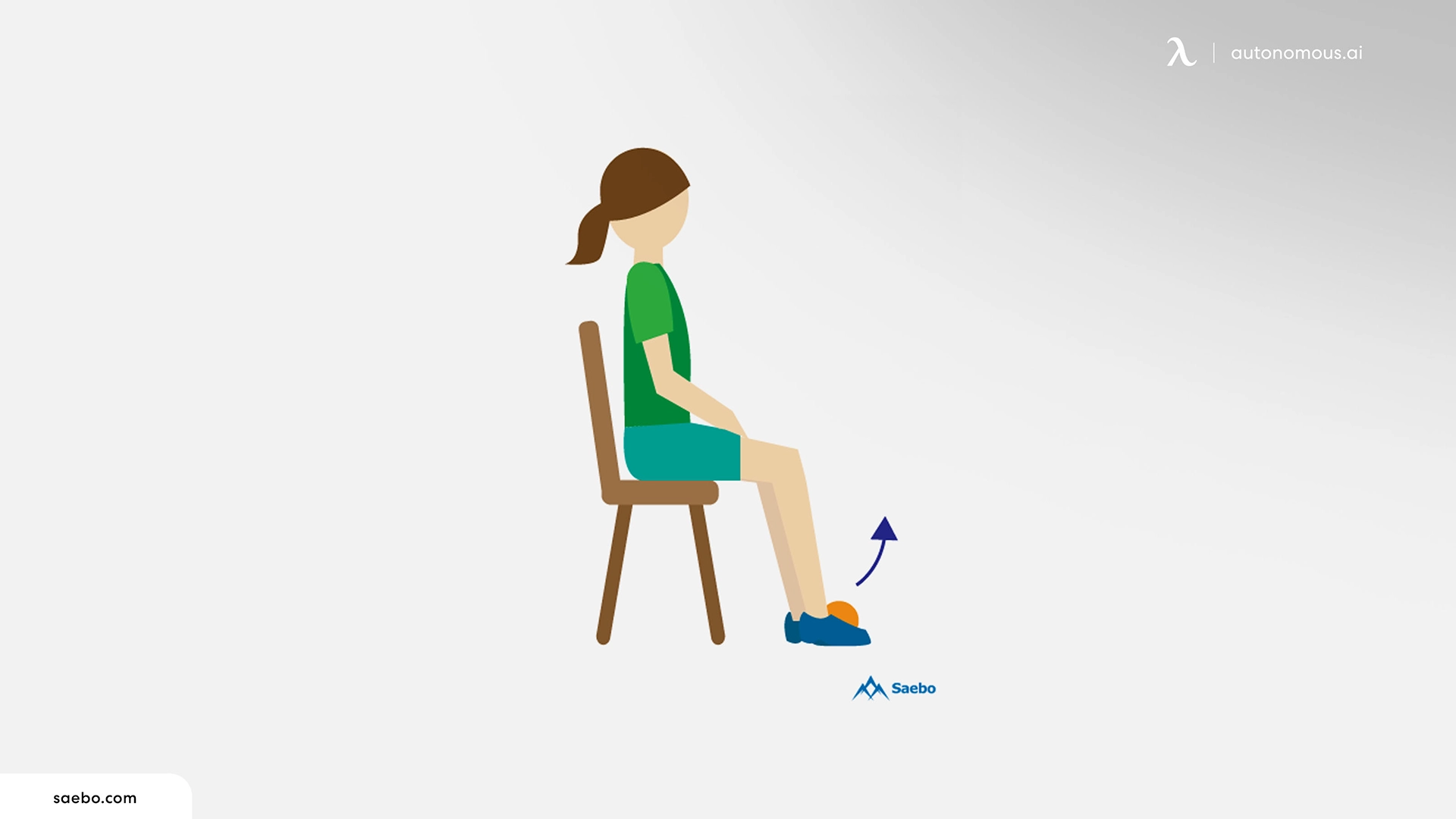
16. Use support equipment
Ergonomic chairs, standing desks, and footrests are a few of the many pieces of equipment people use for comfort while working. Learn and try these equipment to choose what suits you the best.
17. Ankle flexes
Your feet should be firmly placed on the ground, with your legs apart at an angle of 90 degrees. Then, pick up your heels right off the floor and then lower them while lifting your toes off the floor. Try to pull them to your shins. Be sure to rock steadily. Alternatively, raise the heels of one of your feet while raising the toes of the other foot.
18. Foot pumps
Performing lower leg circles after these ankle circles will reduce the amount of fluid accumulated in the leg. Both feet should be lifted toes-down, heels down. Try to reach the highest point possible as you raise your feet. On the backs of your lower legs, you will feel the calf muscles behind your legs stretching - that means you are doing the exercise the right way. Your feet should be flat on the floor when you return to the starting positions. Now try lifting your heels as high as possible while keeping your toes on the ground. go through these same steps a few more times.
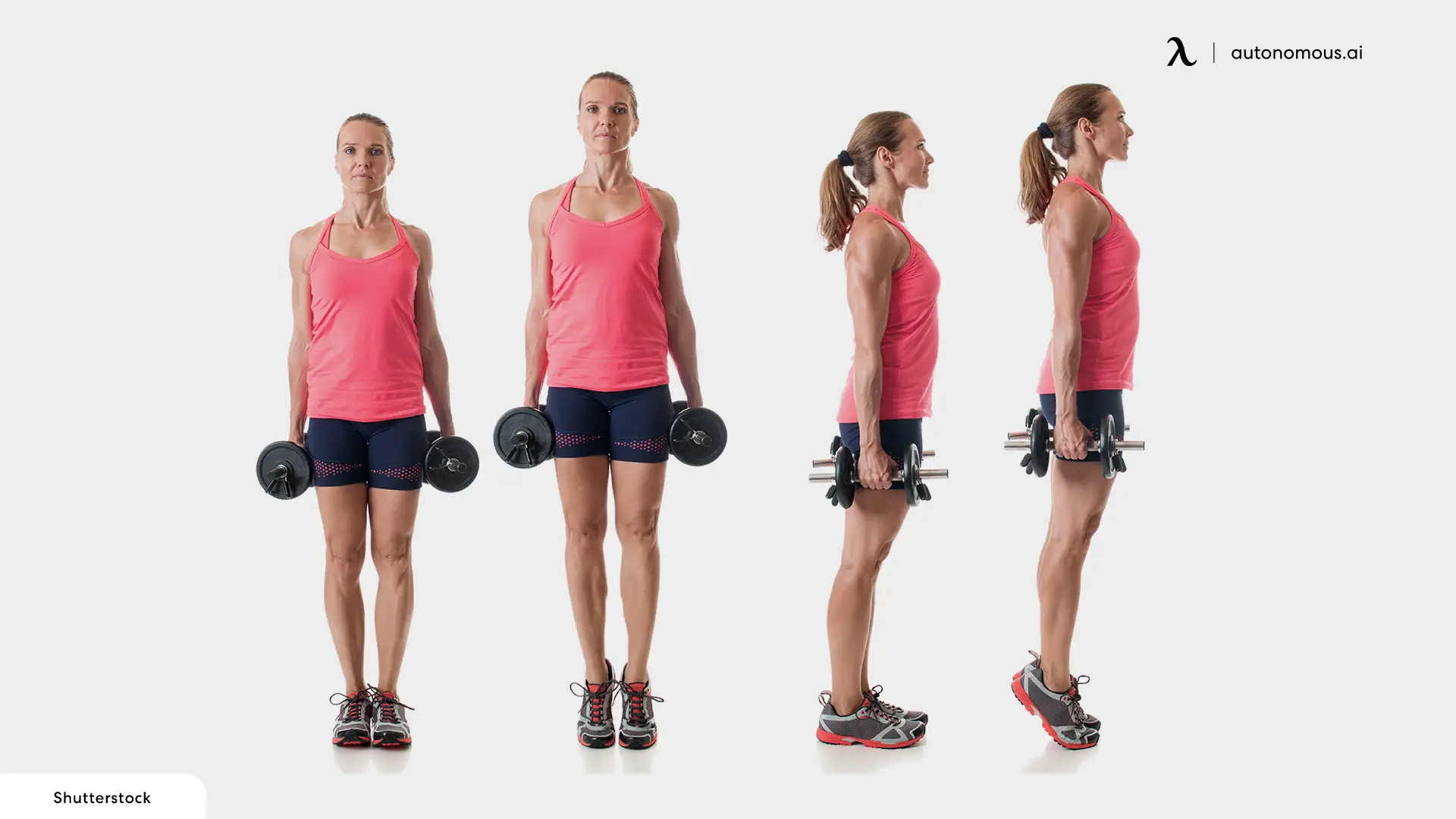
19. Leg lifts
While sitting at your mobile standing desk, raise your other leg to parallel the floor while keeping one foot on the ground. Repeat with the other leg after holding for five seconds. Repeat this process until each leg has been raised 10 times. While lifting your leg, trace a circle with your toes if you want to make this more challenging.
20. Ankle circles
Due to gravity, it is common for fluids to pool around the calves, ankles, and feet. Some of that fluid can be moved with this exercise. You can even do ankle circles or rotate your ankles during a long meeting or seminar. Step one: Lift your foot off the floor slightly and roll your ankle clockwise. Follow one direction for 10 full circles, then change directions. Use your other foot to do the exercise. Each side should be repeated five to ten times.
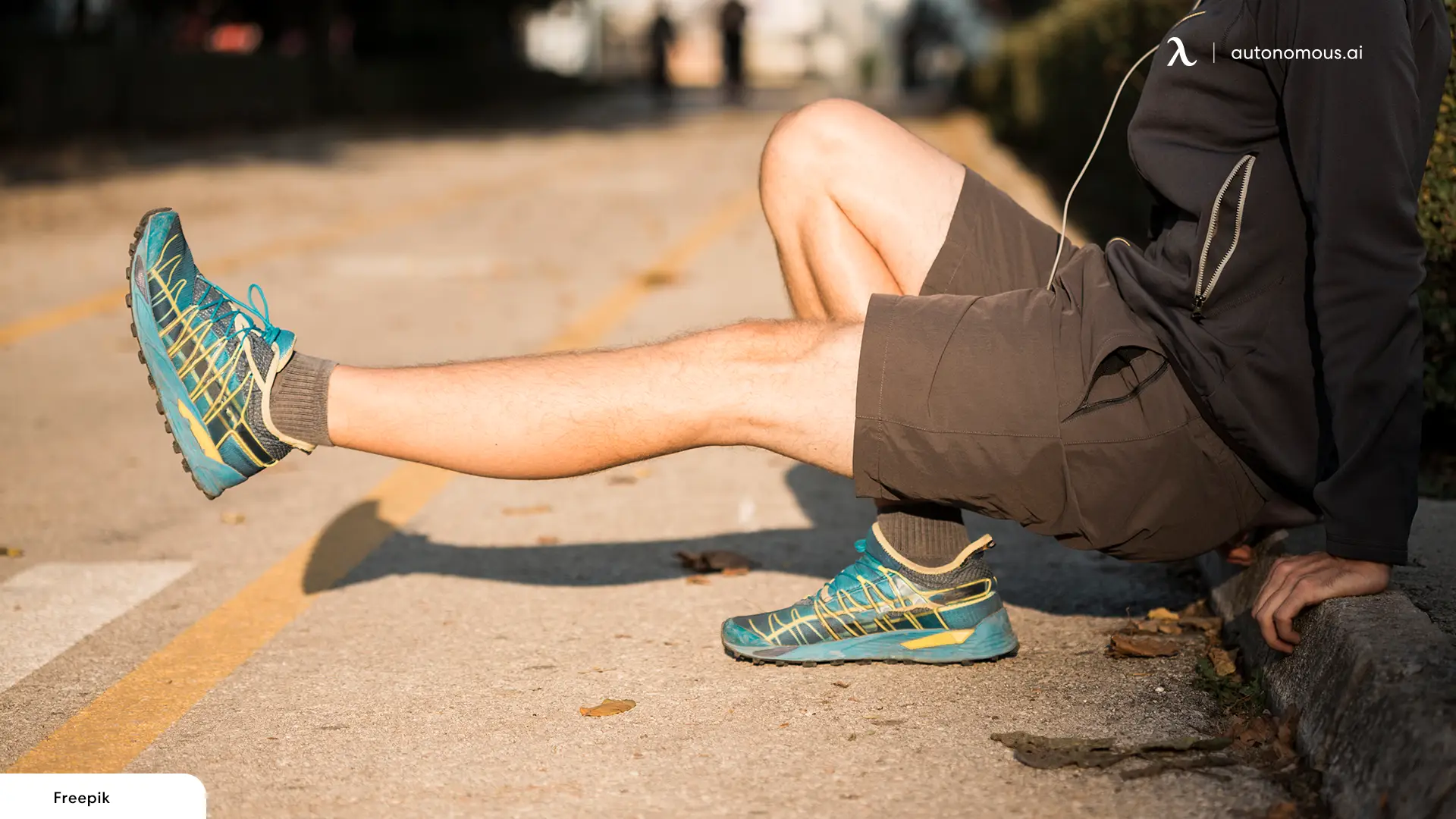
21. Walking
It's a simple question! Try getting up for a brisk, short walk whenever you can. Take the stairs instead of the lift, go visit your colleagues instead of messaging or mailing them, or go for a small walk outside after your lunch break instead of taking the elevator.
FAQs
1. How often should I take breaks to prevent feet swelling?
It's recommended to take short breaks every hour, even if it's just for a couple of minutes. This helps improve blood circulation and prevents excessive fluid accumulation in the feet.
2. When should I seek medical advice for persistent feet swelling at my desk job?
If you experience persistent and severe feet swelling, it may be a sign of an underlying medical condition. Consult a healthcare professional if the swelling is accompanied by pain, redness, warmth, or if it doesn't improve with lifestyle changes.
3. Does swollen feet mean heart failure?
Swollen feet can be one of the symptoms of heart failure, but it is not the sole indicator, and not everyone with swollen feet has heart failure. Heart failure occurs when the heart is unable to pump blood effectively, leading to fluid retention and swelling in various parts of the body, including the feet, ankles, and legs. However, many other conditions can also cause swollen feet, such as kidney problems, venous insufficiency, liver disease, certain medications, and more.
4. When should I be concerned about swollen feet?
You should be concerned about swollen feet when the swelling is persistent, severe, or accompanied by other concerning symptoms. Some specific situations that warrant immediate medical attention include:
- Sudden and severe swelling in one leg, which could indicate a blood clot (deep vein thrombosis).
- Swelling that is accompanied by pain, warmth, or redness, which could indicate an infection.
- Swelling that doesn't improve with elevation and rest.
- Swelling that is associated with difficulty breathing, chest pain, or other signs of a heart or lung problem.
- Swelling in both feet and ankles, along with unexplained weight gain and fatigue, which may be signs of a systemic issue.
If you experience any of these symptoms or are unsure about the cause of your swollen feet, it is essential to seek prompt medical evaluation to determine the underlying cause and appropriate treatment.
Stay connected with us!
Subscribe to our weekly updates to stay in the loop about our latest innovations and community news!
Interested in a Link Placement?
.svg)
.svg)





/https://storage.googleapis.com/s3-autonomous-upgrade-3/production/ecm/230914/bulk-order-sep-2023-720x1200-CTA-min.jpg)

/https://storage.googleapis.com/s3-autonomous-upgrade-3/static/upload/images/new_post_author/admin-1.png)